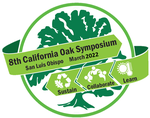#50

Chris Lee, California Department of Forestry and Fire Protection, Fortuna, CA
Yana Valachovic, University of California Cooperative Extension, Eureka, CA
Lenya Quinn-Davidson, University of California Cooperative Extension, Eureka, CA
Jeff Stackhouse, University of California Cooperative Extension, Eureka, CA
Armillaria species are sometimes collectively known in California as the “oak root fungus” for their aggressiveness to oaks. Although this aggressiveness is most obvious in urbanized and agricultural landscapes, it also informs the dynamics of true oak decline under the canopies of encroaching conifers, particularly Douglas-fir in California’s north coastal counties. While studying the effects of encroaching Douglas-fir in Oregon white and California black oak woodlands in Mendocino, Humboldt, and Trinity Counties, we hypothesized that rapid Douglas-fir densification and ensuing stem exclusion (in which Armillaria sp. provides one mechanism of small tree death) would present ideal conditions for Armillaria sp. to spread to oak root systems and infect oaks compromised by the diminishing light resource. Moreover, we wondered whether oaks released from conifer competition by removal treatments, presumably after the establishment of Armillaria infections under shaded conditions, would continue to host significant infections. Upon excavation of white and black oak and Douglas-fir roots in plots treated by Douglas-fir removal and in control (untreated) plots, we observed significantly more signs and symptoms of Armillaria infection in control than treated plots, even though treated plots had numerous Douglas-fir stumps that were being decayed by Armillaria species, representing an enhanced inoculum potential on the plots. This suggests that upon release from light competition with Douglas-firs, true oaks can rapidly mobilize resources to compartmentalize Armillaria and prevent further infection. Finally, we observed this to differ between Oregon white oaks and California black oaks, with the former generally more resistant to Armillaria infection. This distinction is potentially informative for the timing of conifer removal treatments during the encroachment process.
